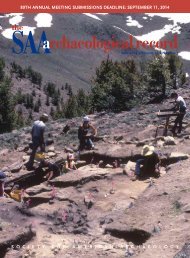SAA
SAA_Record_Nov2015
SAA_Record_Nov2015
You also want an ePaper? Increase the reach of your titles
YUMPU automatically turns print PDFs into web optimized ePapers that Google loves.
PROS AND CONS OF CONSULTING COLLECTORS<br />
would like to explore in this article. I strongly suggest that an<br />
archaeologist who works with responsible collectors should<br />
do the following if they identify a collection that is worthy of<br />
long-term curation in a museum:<br />
• Educate the collector about the minimum data standards<br />
that must be recorded about each object in the collection.<br />
These recording standards provide critical information<br />
for the museum catalog records that will be created when<br />
the collection is donated to a museum in order to facilitate<br />
future research, interpretation, and other uses, such<br />
as exhibits and public outreach. The data standards<br />
should include: artifact type; cultural period; state site<br />
number; collection date; name of collector; state, county,<br />
and name of the place where the object was found; UTM<br />
coordinates or other specific information about the<br />
object’s original location, including in-site provenience;<br />
and the history of any changes to its physical condition<br />
since the object was collected. Additionally, there should<br />
be two or three photographs of each object, e.g., front,<br />
back, and side angle that include a measuring scale. Not<br />
only do the photographs help describe an object— for<br />
instance use wear or other distinctive markings— but<br />
they also help document the condition of the object at the<br />
time it was accepted into the museum.<br />
• Ensure that the collector understands the implications of<br />
donating their collection to a museum. Museums will be<br />
interested in any documentation that proves original<br />
ownership of the collection and will then ask the donor to<br />
sign a deed of gift form that documents the transfer of<br />
ownership to the museum (Sonderman 2004). Most<br />
museums accept only unrestricted gifts, that is, a donation<br />
that identifies the museum as the rightful owner of<br />
the collection without limitations on how the object(s)<br />
must be stored, exhibited, or otherwise used. Furthermore,<br />
a complete donation includes any associated<br />
records, such as a field log book, sketch maps, or other<br />
notes taken about the circumstances of the recovery,<br />
which should be deposited with the objects.<br />
• Help the collector identify a museum that will benefit<br />
from the donation according to its Scope of Collection<br />
Statement 1 or similar document. I recommend that a private<br />
collection is donated to a museum that has a lengthy<br />
history of commitment to long-term collections care and<br />
accessibility for research, heritage uses, education, and<br />
public exhibits and programs.<br />
• Familiarize the collector with the collection acceptance or<br />
submission requirements once a museum is identified.<br />
These conditions are often posted on the museum’s website<br />
or provided by the museum Registrar or appropriate Curator.<br />
They generally include specifications for how the<br />
objects should be cleaned, the types of object storage bags<br />
and boxes that must be used, the labeling system for the<br />
containers, and the cataloging system used by the museum.<br />
• Consult the collector and the museum on how the collector<br />
can contribute financially to the long-term preservation<br />
of the donated collection, either at the time of donation<br />
or later. Since many museums cannot afford to<br />
accept and accession private collections, this step is critical.<br />
Many museums now charge a fee to curate archaeological<br />
collections, which is often presented in the museum’s<br />
acceptance requirements (see also Childs et al.<br />
2010). A basic understanding of the costs and a frank discussion<br />
about estate planning may open the door to the<br />
possibility of donating the collection at the time of the collector’s<br />
passing, along with the necessary financial support.<br />
It is critical that donated private collections do not<br />
become “orphaned” and abandoned by the host institution,<br />
which increasingly happens to systematically recovered<br />
collections, because the donation was incomplete or<br />
was not adequately supported financially.<br />
Instead of donating object collections to museums for longterm<br />
curation, another option to ensure that legitimate private<br />
collections are accessible for future archaeological<br />
research is to thoroughly document them using digital technologies<br />
(Shott 2008). This is certainly feasible and may be<br />
preferable to donation, but it is also important to note the<br />
related costs to this alternative that also need to be financially<br />
supported. It may seem inexpensive for an archaeologist<br />
interested in documenting a private collection to use a digital<br />
camera already purchased for another archaeological investigation<br />
to take photos of the objects in various standardized<br />
positions. However, if the photos are to be made available for<br />
future use by colleagues, they too need to be appropriately<br />
curated. This means that the digital files are properly labeled<br />
and described, backed up in at least two places to prevent<br />
loss, and migrated to new formats that become established<br />
over time to prevent failure and obsolescence. Some museums<br />
offer curation services for digital records, but depositing<br />
the photos in a dedicated digital repository may be a better<br />
solution. In either case, the curation of digital records<br />
also has related costs, upfront fees are generally charged for<br />
this service, and there are submission requirements. If photogrammetry<br />
or 3-D laser scanning is used to record the<br />
objects, then there are the additional expenses of the<br />
machinery and its operation by skilled professionals, as well<br />
as the curation of the large digital files.<br />
34 The <strong>SAA</strong> Archaeological Record • November 2015




